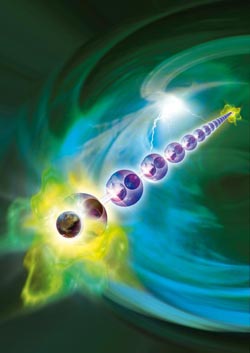Exotic Quantum States: A New Research Approach

Majorana fermions are then generated at both ends of the atomic chain. Graphics: H. Ritsch<br>
They linked concepts of quantum optics and condensed matter physics and show a direction to build a quantum computer which is immune against perturbations. The scientists have published their work in the journal Nature Physics.
Three years ago a research team led by Sebastian Diehl and Peter Zoller presented a completely new approach to engineer quantum states in many-body systems. They used a physical phenomenon that normally increases the degree of disorder in a system dramatically: dissipation. In classical physics dissipation is the concept that explains the production of heat through friction. Surprisingly, in quantum physics dissipation can also lead to order and a completely pure many-body state can be realized. This spring an Innsbruck research team, led by experimental physicist Rainer Blatt, demonstrated experimentally that by using dissipation certain quantum effects can be generated and intensified. By linking concepts of quantum optics and condensed matter physics, theoretical physicists from the Institute of Theoretical Physics of the University of Innsbruck and the Institute for Quantum Optics and Quantum Information of the Austrian Academy of Sciences have now pointed out a new direction of how dissipation may be used in another beneficial and promising way.
Immune against perturbations
In condensed matter physics a new concept to describe order in many-body systems has gained in importance recently: topological order. Two examples for topological phenomena are the quantum Hall effect, which was demonstrated in the 1980s, and the topological insulator, which behaves as an electrical insulator in its interior while permitting the transport of charges on its surface. Sebastian Diehl and Peter Zoller’s team of theoretical physicists now suggest realizing dissipation induced Majorana fermions in a quantum system. This topological phenomenon was named after the Italian physicist Ettore Majorana and describes particles that are their own anti-particles. “We show a new way of how Majorana fermions may be created in a controlled way in a quantum system,“ explains Sebastian Diehl. “For this purpose we use a dissipative dynamic that drives the system into this state in a targeted way and compels it back when affected by disturbances.” With this new approach Diehl and his team combine the advantages of dissipation and topological order – both concepts are highly robust against perturbations such as disorder. Therefore, their suggestion to create Majorana fermions in an atomic quantum wire is of high interest for experimental implementation. It may be used for building a quantum computer whose basic building blocks consist of Majorana fermions. In quantum wires atoms are confined to one-dimensional structures by optical lattices which are generated by laser beams: Majorana fermions are then generated at both ends of the atomic chain.
Checklist
START awardee Sebastian Diehl and his research group have linked the knowledge of condensed matter physics and quantum mechanics. “We work at the interface between those two disciplines, which creates exciting new possibilities,“ says Diehl. First though, they had to prove beyond all doubt that the concept of topological order can be transferred to a dissipative context at all. “We were able to tick off all points on the topological checklist and show that its prerequisites are also valid in a system with dissipative dynamics.” The physicists have published the mathematical proof of this new approach in the journal Nature Physics.
Publication: Topology by Dissipation in Atomic Quantum Wires. S. Diehl, E. Rico, M. A. Baranov, P. Zoller. Nature Physics. 2. Oktober 2011 DOI: 10.1038/nphys2106 http://dx.doi.org/10.1038/nphys2106
Rückfragehinweis:
Dr. Sebastian Diehl
Institute for Theoretical Physics
University of Innsbruck
Phone: +43 512 507-4796
Email: Sebastian.Diehl@uibk.ac.at
http://www.uibk.ac.at/th-physik/qo/
Dr. Christian Flatz
Office for Public Relations
University of Innsbruck
Phone: +43 512 507-32022
Cell: +43 676 872532022
Email: Christian.Flatz@uibk.ac.at
Media Contact
More Information:
http://www.uibk.ac.at/th-physik/qo/All latest news from the category: Physics and Astronomy
This area deals with the fundamental laws and building blocks of nature and how they interact, the properties and the behavior of matter, and research into space and time and their structures.
innovations-report provides in-depth reports and articles on subjects such as astrophysics, laser technologies, nuclear, quantum, particle and solid-state physics, nanotechnologies, planetary research and findings (Mars, Venus) and developments related to the Hubble Telescope.
Newest articles

NASA: Mystery of life’s handedness deepens
The mystery of why life uses molecules with specific orientations has deepened with a NASA-funded discovery that RNA — a key molecule thought to have potentially held the instructions for…

What are the effects of historic lithium mining on water quality?
Study reveals low levels of common contaminants but high levels of other elements in waters associated with an abandoned lithium mine. Lithium ore and mining waste from a historic lithium…

Quantum-inspired design boosts efficiency of heat-to-electricity conversion
Rice engineers take unconventional route to improving thermophotovoltaic systems. Researchers at Rice University have found a new way to improve a key element of thermophotovoltaic (TPV) systems, which convert heat…



